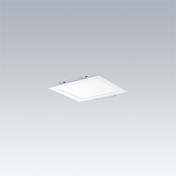Omega Pro 2 Mini / OP2 1800-940 MPT BC Q300 MRP
96634476
▼ Data Sheet
A shallow, versatile edge lit LED luminaire for lay-in and plasterboard ceilings as well as surface mounting with additional collar. LED driver, Wireless controlled via App with Bluetooth® 4.x - basicDIM Wireless. Class II electrical (this product is not earthed), IP20, Impact strength: IK03. Body: steel sheet, finished white (close to RAL9016). Diffuser: UV-stabilised polycarbonate microprismatic optic for maximised spacing. Electrical connection via piano key terminals, loop-in/loop-out possible. Complete with 4000K LED, Colour Rendering Index min.: 90
Radio definition: basicDIM Wireless - Bluetooth® 4.x, Radio frequency: 2.4...2.483 GHz, Radio power: +4 dBm.
Dimensions: 297 x 297 x 46 mm
Luminaire input power: 18.3 W
Luminaire luminous flux: 1800 lm
Luminaire efficacy: 98 lm/W
Weight: 1.25 kg
- LED
- CE
- ENEC11
- GLedReP
- 650°
- IK03
- IP40_IP20
- LLedNr
- RG0
- SC2
- Ta=0°C_to_+35°C

